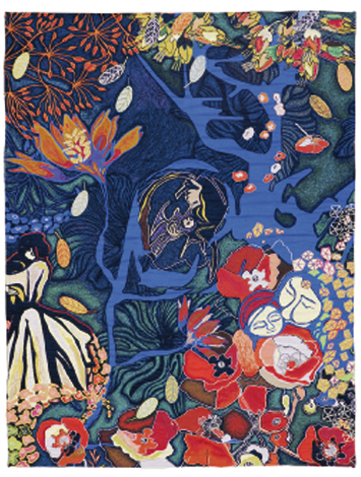 Talva Design lauréat du concours
Talva Design lauréat du concours
PRIX JULES PANSU – VILLE DE PARIS
un regard contemporain sur la tapisserie
Un regard contemporain sur la tapisserie
Les Etablissements Jules Pansu en partenariat avec la Ville de Paris ont lancé en janvier dernier un concours pour la création d’un carton de tapisserie murale décorative, dont l’objectif est de proposer un regard contemporain sur la tapisserie permettant de valoriser toute la variété des techniques liées à ce savoir-faire.
Tal Waldman (Talva Design) a remporté ce premier concours avec un carton intitulé Le Jardin de la création.
Le projet lauréat sera réalisée aux Tissages de la Lys (Groupe Pansu) par les Meilleurs Ouvriers de France et fera l’objet d’une édition commerciale. .
La tapisserie sera exposée aux Ateliers de Paris durant les Designer’s days en juin 2009.
Talva Design winner of the competition
PRICE JULES PANSU – CITY OF PARIS
A contemporary look on tapestry
The Pansu group in partnership with the city of Paris launched a competition in January 09, for the creation of a decorative wall tapestry. The objective of the competition was to propose a contemporary view on tapestry permitting to promote various techniques connected to this tradition.
Tal Waldman (Talva Design) won this competition with a project entitled ‘The garden of creation’.
The winning project will be realized in Lilly weaving (Pansu group) by the ‘Meilleurs Ouvriers de France’ (best artisans of France) and will be published and marketed.
The tapestry will be presented in an exposition at the ‘Ateliers de Paris’ next June during the Designer Days.
Présentation : « Le jardin de la création »
La création absolue, la création de la vie, se fond avec les mythologies du jardin, le jardin d’Éden et le jardin païen comme lieux de création et de vie. Une mythologie personnelle est ainsi créée : « Le jardin de la création ».
Au centre du jardin, la grotte, lieu mystérieux, sombre, inconnu : l’utérus. Symbole du mystère de la naissance et de la création. Représenté par une mère et son enfant.
Autour on trouve le jardin et l’apparition de la mère de la nature, couronnée de fleurs, la reine du jardin et de la forêt. Elle apparaît d’un arbre, avec un enfant et les fleurs.
La seule mère « humaine » sort du jardin avec un bébé dans ses bras, renvoyant, par une interprétation personnelle, à la sortie du jardin d’Éden : la séparation du jardin de la création vers la vie.
Traditionnellement, la tapisserie révèle des secrets, des messages, des mythologies, des histoires. Il m’a paru naturel de proposer une interprétation personnelle, intime, d’un thème cependant universel et intemporel.
La création – pleine de secrets, d’obscurité, mais aussi de beauté et d’optimisme – n’est pas réservée à l’artiste ou à la mère, mais appartient à chacun, à chaque moment.
Presentation « The garden of creation »
The absolute creation, creation of life, mixes with garden mythologies, Garden of Eden, a pagan garden as a place of life creation. A personal mythology is then created: “The garden of Creation”.
In the garden centre, the grotto (cave), a mysterious place, dark, unknown: the uterus, symbol of creation and birth. Represented here by the mother and her child.
Around we find the garden and an apparition of Mother Nature, crowned with flowers, queen of the garden and the forest. She appears from a tree with her child and flowers.
The only ‘human’ mother leaves the garden with a baby in her bras, sent, in a personnel interpretation, to leave the Garden of Eden: the separation from the garden of creation into life.
Traditionally, tapestry reveals secrets, messages, mythologies, stories. It appeared natural to me to propose an intimate and personnel interpretation to a universal and in temporal theme.
The creation, full of secrets, obscurity, as well as beauty and optimism should not be reserved to the artist or the mother, but belong to each and one of us, in each moment.


